The global molybdenum-niobium alloy target market is valued at USD 186.4 million in 2025 and is set to reach USD 492.3 million by 2035, recording an absolute increase of USD 305.9 million over the forecast period. This translates into a total growth of 164.1%, with the market forecast to expand at a CAGR of 10.2% between 2025 and 2035. The market size is expected to grow by approximately 2.6 times during the same period, supported by increasing demand for advanced semiconductor fabrication processes, growing adoption of high-performance aerospace components, and rising requirements for specialized vacuum deposition applications across electronics manufacturing and industrial coating sectors.
The global market represents a specialized segment within the advanced materials and thin film deposition industry, driven by the superior thermal stability characteristics of molybdenum-niobium compositions and the precise sputtering capabilities of refractory metal alloys. These specialized targets operate through physical vapor deposition processes, providing uniform film thickness and controlled deposition rates for various substrate applications including silicon wafers, glass substrates, and specialized ceramic components. The molybdenum-niobium alloy composition enables precise atomic-level deposition control, making these materials particularly suitable for semiconductor device fabrication and high-temperature industrial coating applications.

The market encompasses various target geometries, purity levels, and specialized compositions tailored for specific deposition applications. Modern molybdenum-niobium alloy targets incorporate advanced powder metallurgy techniques, controlled grain structures, and enhanced surface preparation methods that can operate efficiently under high-vacuum conditions while maintaining consistent performance over extended sputtering cycles. The integration of quality assurance protocols, trace element control systems, and predictive performance monitoring has further enhanced the value proposition of these target materials among semiconductor manufacturers seeking process reliability and film quality optimization.
Market dynamics are significantly influenced by stringent semiconductor manufacturing requirements, particularly in advanced node fabrication applications, integrated circuit production, and specialized electronic device manufacturing where deposition precision and material purity are paramount. The electronics sector's increasing focus on miniaturization, performance enhancement, and reliability standards has created substantial demand for high-performance target materials in magnetron sputtering systems, electron beam evaporation processes, and advanced coating applications. The growing trend toward aerospace component manufacturing and high-temperature industrial applications has amplified the need for refractory metal targets capable of delivering consistent deposition characteristics and superior film properties.
Consumer purchasing patterns show a marked preference for target systems that combine molybdenum-niobium alloy performance with versatile geometry options, multiple purity configurations, and comprehensive material certification features for diverse manufacturing applications. The market has witnessed significant technological advancement in alloy composition optimization, target bonding technology development, and surface preparation systems, making these materials more suitable for demanding operational environments, extended service cycles, and quality-critical applications.
Between 2025 and 2030, the market is projected to expand from USD 186.4 million to USD 302.9 million, resulting in a value increase of USD 116.5 million, which represents 38.1% of the total forecast growth for the decade. This phase of development will be shaped by increasing semiconductor fabrication capacity expansion, rising demand for advanced deposition materials, and growing availability of specialized powder metallurgy production capabilities across electronics manufacturing and aerospace coating applications.
Between 2030 and 2035, the market is forecast to grow from USD 302.9 million to USD 492.3 million, adding another USD 189.4 million, which constitutes 61.9% of the overall ten-year expansion. This period is expected to be characterized by the advancement of next-generation semiconductor technologies, the development of specialized alloy compositions for emerging applications, and the expansion of high-performance coating networks across diverse industrial and electronics applications. The growing focus on process optimization and material performance will drive demand for premium target varieties with enhanced deposition characteristics, improved structural uniformity, and superior service life performance profiles.
| Metric | Value |
|---|---|
| Estimated Value in (2025E) | USD 186.4 million |
| Forecast Value in (2035F) | USD 492.3 million |
| Forecast CAGR (2025 to 2035) | 10.2% |
Between 2020 and 2024, the market experienced robust growth, driven by increasing awareness of advanced material requirements and growing recognition of specialized target systems' effectiveness in supporting high-performance deposition operations across semiconductor fabrication and aerospace coating applications. The market developed as users recognized the potential for molybdenum-niobium alloy targets to deliver operational advantages while meeting modern requirements for precise film deposition and reliable process performance. Technological advancement in alloy composition optimization and target manufacturing began emphasizing the critical importance of maintaining material consistency while extending target life and improving user satisfaction across diverse sputtering applications.
Market expansion is being supported by the increasing global focus on semiconductor manufacturing advancement and the corresponding shift toward high-performance deposition materials that can provide superior alloy characteristics while meeting user requirements for precision sputtering operation and cost-effective manufacturing solutions. Modern semiconductor manufacturers are increasingly focused on incorporating target materials that can enhance process reliability while satisfying demands for consistent, precisely controlled thin film deposition and optimized material utilization practices. Molybdenum-niobium alloy targets' proven ability to deliver high-temperature excellence, deposition uniformity benefits, and diverse application possibilities makes them essential components for technology-focused facilities and quality-focused electronics professionals.
The growing focus on advanced semiconductor nodes and manufacturing process optimization is driving demand for high-performance target materials that can support distinctive deposition outcomes and comprehensive process control across sputtering applications, evaporation systems, and premium electronics manufacturing. User preference for target solutions that combine functional excellence with material reliability is creating opportunities for innovative implementations in both traditional and emerging semiconductor applications. The rising influence of aerospace manufacturing and advanced coating technologies is also contributing to increased adoption of refractory metal targets that can provide authentic performance benefits and reliable deposition characteristics.
The market is segmented by type, application, geometry, purity level, and region. By type, the market is divided into powder metallurgy targets, vacuum melting targets, and other manufacturing methods. Based on application, the market is categorized into semiconductor field, aerospace field, industrial coating, and others. By geometry, the market includes planar targets, rotary targets, and specialty configurations. By purity level, the market encompasses high purity, ultra-high purity, and standard purity categories. Regionally, the market is divided into North America, Europe, Asia Pacific, Latin America, Middle East & Africa, and other regions.

The powder metallurgy targets segment is projected to account for 65.6% of the market in 2025, reaffirming its position as the leading manufacturing method category. Semiconductor manufacturers and coating professionals increasingly utilize powder metallurgy systems for their superior microstructural control characteristics, established quality standards, and essential functionality in diverse high-performance deposition applications across multiple technology sectors. Powder metallurgy targets' proven performance characteristics and established cost-effectiveness directly address user requirements for reliable sputtering control and optimal deposition precision in semiconductor and aerospace applications.
This manufacturing segment forms the foundation of modern high-performance deposition patterns, as it represents the production method with the greatest material consistency and established compatibility across multiple sputtering systems. Manufacturing investments in advanced powder processing technology and quality optimization continue to strengthen adoption among performance-focused users. With semiconductor manufacturers prioritizing material reliability and process consistency, powder metallurgy systems align with both performance objectives and quality requirements, making them the central component of comprehensive deposition strategies.
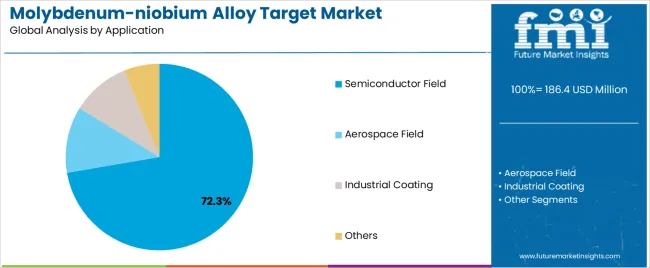
Semiconductor field is projected to represent 72.3% of the market in 2025, underscoring its critical role as the primary application for technology-focused users seeking superior deposition benefits and enhanced manufacturing credentials. Semiconductor manufacturers and device producers prefer semiconductor applications for their established performance requirements, proven technology demand, and ability to maintain exceptional process precision while supporting versatile fabrication coverage during diverse manufacturing activities. Positioned as essential applications for performance-focused semiconductor manufacturers, semiconductor offerings provide both operational excellence and technology advancement advantages.
The segment is supported by continuous improvement in semiconductor fabrication technology and the widespread availability of established semiconductor standards that enable performance assurance and premium positioning at the facility level. Semiconductor users are optimizing target selections to support process-specific applications and comprehensive manufacturing strategies. As semiconductor technology continues to advance and facilities seek efficient deposition methods, semiconductor applications will continue to drive market growth while supporting operational efficiency and process optimization strategies.
The molybdenum-niobium alloy target market is advancing rapidly due to increasing semiconductor manufacturing expansion and growing need for advanced deposition materials that emphasize superior alloy performance across electronics segments and manufacturing applications. The market faces challenges, including competition from alternative target materials, raw material cost volatility considerations, and technical complexity factors affecting adoption rates. Innovation in alloy composition enhancement and advanced manufacturing systems continues to influence market development and expansion patterns.
The growing adoption of molybdenum-niobium alloy targets with advanced semiconductor compatibility and next-generation device integration is enabling users to develop deposition strategies that provide distinctive performance benefits while commanding precise process control and enhanced real-time quality monitoring characteristics. Advanced node applications provide superior deposition consistency while allowing more sophisticated process optimization features across various semiconductor categories. Users are increasingly recognizing the operational advantages of specialized target positioning for comprehensive manufacturing outcomes and technology-integrated facility management.
Modern molybdenum-niobium alloy target manufacturers are incorporating advanced deposition sensors, real-time performance monitoring capabilities, and process analytics systems to enhance operational precision, improve material utilization effectiveness, and meet manufacturing demands for intelligent deposition control solutions. These systems improve manufacturing effectiveness while enabling new applications, including continuous process monitoring programs and automated optimization protocols. Advanced analytics integration also allows users to support proactive material positioning and performance assurance beyond traditional sputtering operation requirements.
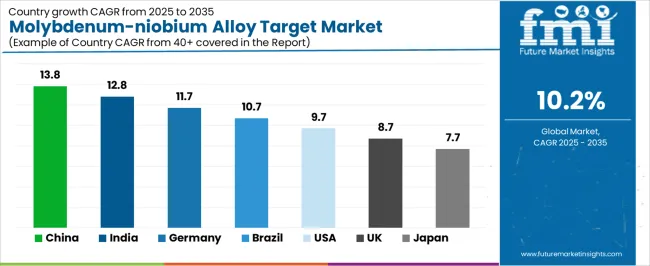
| Country | CAGR (2025-2035) |
|---|---|
| China | 13.8% |
| India | 12.8% |
| Germany | 11.7% |
| Brazil | 10.7% |
| USA | 9.7% |
| UK | 8.7% |
| Japan | 7.7% |
The market is experiencing robust growth globally, with China leading at a 13.8% CAGR through 2035, driven by the expanding semiconductor manufacturing sector, growing electronics production requirements, and increasing adoption of advanced deposition technologies. India follows at 12.8%, supported by rising technology investment, expanding electronics manufacturing industry, and growing acceptance of specialized materials technologies. Germany shows growth at 11.7%, emphasizing established engineering standards and comprehensive manufacturing development. Brazil records 10.7%, focusing on industrial modernization and technology adoption growth. USA demonstrates 9.7% growth, prioritizing advanced semiconductor technologies and manufacturing optimization.
The report covers an in-depth analysis of 40+ countries, top-performing countries are highlighted below.
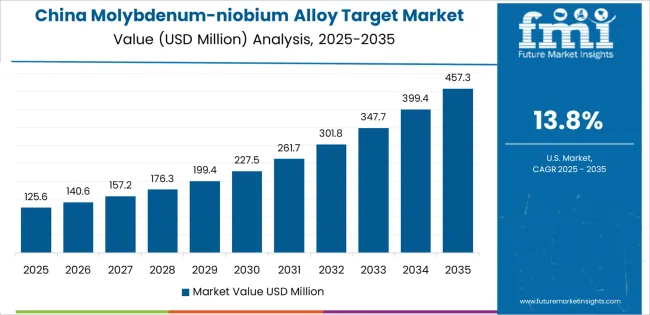
Revenue from molybdenum-niobium alloy target consumption and sales in China is projected to exhibit exceptional growth with a CAGR of 13.8% through 2035, driven by the country's rapidly expanding semiconductor manufacturing sector, favorable government policies toward technology advancement, and initiatives promoting advanced materials technologies across major industrial regions. China's position as a global electronics manufacturing hub and increasing focus on semiconductor self-sufficiency are creating substantial demand for high-quality molybdenum-niobium alloy targets in both domestic and export markets. Major electronics companies and material distributors are establishing comprehensive target capabilities to serve growing demand and emerging technology opportunities.
India is expanding at a CAGR of 12.8%, supported by rising technology investment, growing electronics consciousness, and expanding material distributor capabilities. The country's developing electronics infrastructure and increasing investment in semiconductor technologies are driving demand for target materials across both traditional and modern manufacturing applications. International materials companies and domestic distributors are establishing comprehensive operational networks to address growing market demand for advanced deposition materials and efficient manufacturing solutions.
Germany is projected to grow at a CAGR of 11.7% through 2035, supported by the country's mature engineering standards, established manufacturing regulations, and leadership in materials technology. Germany's sophisticated manufacturing standards and strong support for advanced materials systems are creating steady demand for both traditional and innovative target varieties. Leading materials manufacturers and specialty distributors are establishing comprehensive operational strategies to serve both domestic markets and growing export opportunities.
Revenue from molybdenum-niobium alloy target products in Brazil is projected to grow at a CAGR of 10.7% through 2035, driven by the country's focus on industrial development, manufacturing modernization growth, and growing materials distributor capabilities. Brazilian manufacturing users and industrial facilities consistently seek performance-focused materials that enhance operational performance and support modernization excellence for both traditional and modern manufacturing applications. The country's position as a Latin American industrial leader continues to drive innovation in specialized deposition applications and manufacturing standards.
USA is projected to grow at a CAGR of 9.7% through 2035, supported by the country's focus on semiconductor advancement, manufacturing optimization, and advanced materials integration requiring efficient deposition solutions. American semiconductor manufacturers and technology-focused facilities prioritize performance reliability and process precision, making specialized molybdenum-niobium alloy targets essential components for both traditional and modern manufacturing applications. The country's comprehensive semiconductor leadership and advancing technology patterns support continued market expansion.
Revenue from molybdenum-niobium alloy target products in UK is projected to grow at a CAGR of 8.7% through 2035, supported by established manufacturing standards, mature technology markets, and focus on materials performance across industrial and electronics sectors. British manufacturing users and technology professionals prioritize quality performance and operational consistency, creating steady demand for premium target solutions. The country's comprehensive market maturity and established manufacturing practices support continued development in specialized applications.
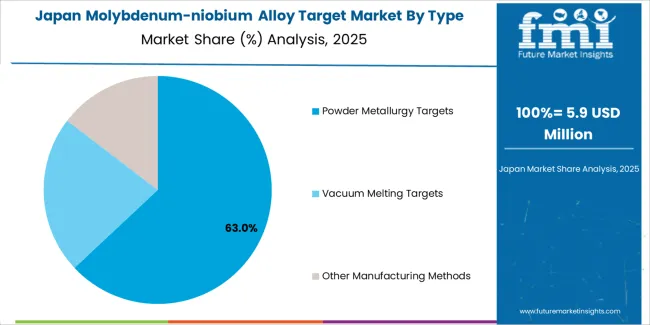
Japan is projected to grow at a CAGR of 7.7% through 2035, supported by the country's focus on precision engineering, operational excellence, and advanced technology integration requiring efficient deposition solutions. Japanese semiconductor manufacturers and technology-focused facilities prioritize technical performance and engineering precision, making specialized molybdenum-niobium alloy targets essential components for both traditional and modern manufacturing applications. The country's comprehensive engineering leadership and advancing precision patterns support continued market expansion.
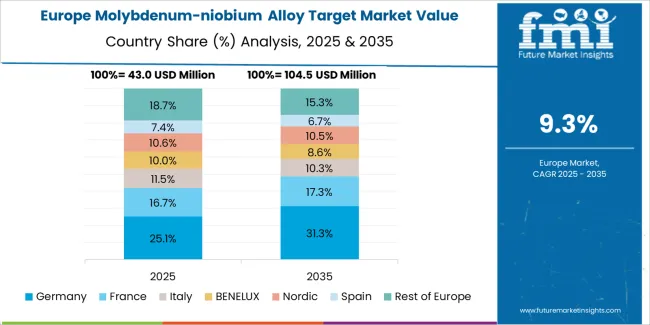
The Europe molybdenum-niobium alloy target market is projected to grow from USD 47.8 million in 2025 to USD 126.2 million by 2035, recording a CAGR of 10.2% over the forecast period. Germany leads the region with a 43.2% share in 2025, moderating slightly to 42.8% by 2035, supported by its strong materials engineering traditions and demand for premium, precision-manufactured target solutions. The United Kingdom follows with 21.7% in 2025, easing to 21.3% by 2035, driven by a mature technology market and focus on materials performance and quality excellence. France accounts for 14.8% in 2025, rising to 15.2% by 2035, reflecting steady adoption of advanced materials technologies and manufacturing optimization. Italy holds 8.4% in 2025, expanding to 9.1% by 2035 as industrial modernization and specialty technology applications grow. Spain contributes 5.7% in 2025, growing to 6.0% by 2035, supported by expanding manufacturing development and technology awareness modernization. The Nordic countries rise from 3.5% in 2025 to 3.7% by 2035 on the back of strong technology consciousness and advanced manufacturing methodologies. BENELUX remains at 2.7% share across both 2025 and 2035, reflecting mature, performance-focused manufacturing markets.
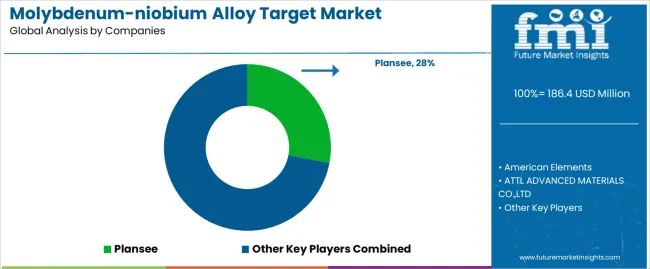
The market is characterized by competition among established materials manufacturers, specialized target companies, and integrated deposition solution providers. Companies are investing in advanced alloy composition technologies, specialized manufacturing engineering, product innovation capabilities, and comprehensive distribution networks to deliver consistent, high-quality, and reliable target materials. Innovation in alloy optimization, manufacturing process advancement, and performance-focused product development is central to strengthening market position and customer satisfaction.
Plansee leads the market with 28% share with a strong focus on materials technology innovation and comprehensive deposition solutions, offering semiconductor and industrial systems with focus on performance excellence and engineering heritage. American Elements provides integrated materials supply with a focus on specialty market applications and precision quality networks. ATTL ADVANCED MATERIALS CO.,LTD delivers comprehensive target technology solutions with a focus on manufacturing positioning and operational efficiency. Praxair Inc. specializes in comprehensive materials systems with a focus on industrial applications. MOSTEN focuses on comprehensive target materials with advanced design and premium positioning capabilities.
The success of molybdenum-niobium alloy targets in meeting semiconductor manufacturing demands, deposition quality requirements, and operational integration will not only enhance manufacturing performance outcomes but also strengthen global materials technology capabilities. It will consolidate emerging regions' positions as hubs for efficient target production and align advanced economies with comprehensive materials systems. This calls for a concerted effort by all stakeholders -- governments, industry bodies, manufacturers, distributors, and investors. Each can be a crucial enabler in preparing the market for its next phase of growth.
How Governments Could Spur Local Production and Adoption?
How Industry Bodies Could Support Market Development?
How Distributors and Materials Players Could Strengthen the Ecosystem?
How Manufacturers Could Navigate the Shift?
| Items | Values |
|---|---|
| Quantitative Units (2025) | USD 186.4 million |
| Type | Powder Metallurgy Targets, Vacuum Melting Targets, Other Manufacturing Methods |
| Application | Semiconductor Field, Aerospace Field, Industrial Coating, Others |
| Geometry | Planar Targets, Rotary Targets, Specialty Configurations |
| Purity Level | High Purity, Ultra-High Purity, Standard Purity |
| Regions Covered | North America, Europe, Asia Pacific, Latin America, Middle East & Africa, Other Regions |
| Countries Covered | China, India, Germany, Brazil, United States, United Kingdom, Japan, and 40+ countries |
| Key Companies Profiled | Plansee, American Elements, ATTL ADVANCED MATERIALS CO.,LTD, Praxair Inc., MOSTEN, and other leading molybdenum-niobium alloy target companies |
| Additional Attributes | Dollar sales by type, application, geometry, purity level, and region; regional demand trends, competitive landscape, technological advancements in target engineering, alloy optimization initiatives, performance enhancement programs, and premium product development strategies |
The global molybdenum-niobium alloy target market is estimated to be valued at USD 186.4 million in 2025.
The market size for the molybdenum-niobium alloy target market is projected to reach USD 492.3 million by 2035.
The molybdenum-niobium alloy target market is expected to grow at a 10.2% CAGR between 2025 and 2035.
The key product types in molybdenum-niobium alloy target market are powder metallurgy targets, vacuum melting targets and other manufacturing methods.
In terms of application, semiconductor field segment to command 72.3% share in the molybdenum-niobium alloy target market in 2025.






Full Research Suite comprises of:
Market outlook & trends analysis
Interviews & case studies
Strategic recommendations
Vendor profiles & capabilities analysis
5-year forecasts
8 regions and 60+ country-level data splits
Market segment data splits
12 months of continuous data updates
DELIVERED AS:
PDF EXCEL ONLINE
Halloysite Market Size and Share Forecast Outlook 2025 to 2035
Superalloys Market Size and Share Forecast Outlook 2025 to 2035
Ferroalloy Market Size and Share Forecast Outlook 2025 to 2035
Metal Alloys Market Size and Share Forecast Outlook 2025 to 2035
Braze Alloys Market Growth - Trends & Forecast 2025 to 2035
Nickel Alloy Market
Aluminum Alloy Sacrificial Anode Market Size and Share Forecast Outlook 2025 to 2035
Aluminum Alloys Market Size and Share Forecast Outlook 2025 to 2035
Zinc-tin Alloy Sputtering Target Market Size and Share Forecast Outlook 2025 to 2035
Automotive Alloys Market Size and Share Forecast Outlook 2025 to 2035
Nickel Superalloy Market Size and Share Forecast Outlook 2025 to 2035
High Entropy Alloy Market Size and Share Forecast Outlook 2025 to 2035
Shape Memory Alloy Market Size and Share Forecast Outlook 2025 to 2035
Solar Aluminum Alloy Frame Market Size and Share Forecast Outlook 2025 to 2035
High Temperature Alloys Market Growth - Trends & Forecast 2025 to 2035
Copper and Copper Alloy Scrap and Recycling Market Size and Share Forecast Outlook 2025 to 2035
Aviation Titanium Alloy Market Analysis by Type, Application, Microstructure, and Region: Forecast for 2025 to 2035
Beryllium Aluminum Alloy Market Growth - Trends & Forecast 2025 to 2035
India Shape Memory Alloy Market Analysis by Material Type, Component Type, Application, End Use Industry, and Region Forecast Through 2025 to 2035
Centrifugal Casting Alloy Powder Market Size and Share Forecast Outlook 2025 to 2035

Thank you!
You will receive an email from our Business Development Manager. Please be sure to check your SPAM/JUNK folder too.
Chat With
MaRIA